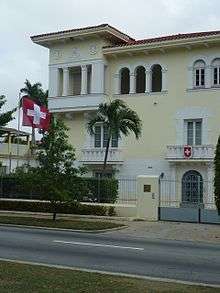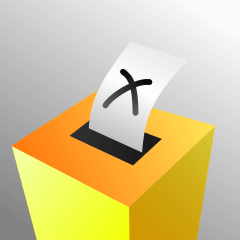Protecting power
A protecting power is a country that represents another sovereign state in a country where it lacks its own diplomatic representation. It is common for protecting powers to be appointed when two countries break off diplomatic relations with each other. The protecting power is responsible for looking after the sending state's diplomatic property and citizens in the hosting state. If diplomatic relations were broken by the outbreak of war, the protecting power will also inquire into the welfare of prisoners of war and look after the interests of civilians in enemy-occupied territory.

The institution of protecting power dates back to the Franco-Prussian War of 1870 and was formalized in the Geneva Convention of 1929. Protecting powers are authorized in all four of the Geneva Conventions of 1949. In addition, the International Red Cross may itself be appointed a protecting power under Protocol I (1977). The practice of selecting a protecting power in time of peace was formalized in the Vienna Convention on Diplomatic Relations (1961).[2][3]
Diplomacy

The protecting power is appointed by the sending state and must also be acceptable to the host state. It must therefore maintain diplomatic relations with both states. In time of war, the Geneva Conventions also require the protecting power to be a neutral country. The specific responsibilities and arrangements are agreed between the protecting power, the sending state, and the host country.
In a comprehensive mandate, the protecting power carries out most diplomatic functions on behalf of the protected state. This is necessary when relations are so hostile that the sparring nations have no diplomatic or consular staff posted on each other's territory. For example, Sweden carries out limited consular functions for the United States, Canada, and Australia in North Korea.[4]
In other cases, the two nations have broken diplomatic relations, but are nevertheless willing to exchange personnel on an informal basis. The protecting power serves as the mechanism for facilitating this exchange. The embassy of the protected state is staffed by its own diplomatic personnel, but it is formally termed an "interests section" of the protecting power. Between 1991 and 2015, the Cuban Interests Section was staffed by Cubans and occupied the old Cuban embassy in Washington, D.C., but it was formally a section of the Swiss Embassy to the United States. When relations are exceptionally tense, however, such as during a war, the "interests section" is instead staffed by diplomats from the protecting power. For example, when Iraq and the U.S. broke diplomatic relations due to the Gulf War, Poland became the protecting power for the United States. The United States Interests Section of the Polish Embassy in Iraq was headed by a Polish diplomat.[5]
There is no requirement that the same protecting power be selected by both countries, although this is convenient for the purposes of communication. Each may appoint a different protecting power, provided that the choice is acceptable to the other state. There is also no requirement that a country select only one protecting power in the receiving country. During the Second World War, Japan appointed Spain, Sweden and Switzerland to be its protecting powers in the United States.[6]
Current mandates
History
Origins
Although protecting powers have existed in diplomatic usage since the 16th century, the modern institution of protecting power originated in the Franco-Prussian War of 1870–1871.[6][30]:550 All of the belligerents appointed protecting powers, necessitated by the expulsion of diplomats and placing of restrictions on enemy aliens.[6] The United States acted as protecting power for the North German Confederation and several of the smaller German states, while Switzerland was the protecting power for Baden and Bavaria, and Russia for Württemberg.[31] Meanwhile, the United Kingdom served as the protecting power for France.
The energetic efforts of Elihu B. Washburne, the United States Minister to France, set a precedent for the actions of protecting powers in war.[32] The American flag was raised over the North German Embassy, and the embassy archives were transferred to the U.S. legation for safekeeping. Washburne arranged for the evacuation of 30,000 North German subjects from France in the opening days of the war. As the only chief of mission from a major power to remain in the French capital during the Siege of Paris, he was also charged with the protection of seven Latin American consulates and was responsible for feeding 3,000 German civilians who were stuck in the city.[31][33]
Early developments
After the Franco-Prussian War, the appointment of protecting powers became customary international law. In subsequent wars, the protecting powers expanded their duties with the consent of the belligerents. In the First Sino-Japanese War, both sides selected the United States as their protecting power, establishing the concept of a reciprocal mandate. During the Spanish–American War, the United States requested neutral inspection of prisoner of war camps for the first time.[6]
Since the institution of protecting power had not been formalized by treaty, disputes arose over the protecting power's rights and responsibilities. In the Second Boer War, the British Empire selected the United States to be its protecting power, but the Boers refused to allow the U.S. to transmit funds from the British government to prisoners of war. The Netherlands, acting as the protecting power for the Boer Republics, was also unable to secure an agreement to exchange the names of prisoners of war. Two years later during the Russo-Japanese War, the belligerents agreed to exchange lists of prisoners, communicating through France as the protecting power for Russia, and the United States as the protecting power for Japan. The practice of swapping prisoner lists became customary and was eventually included in the Geneva Convention of 1929.[34]
World Wars
The United States was initially a popular choice for protecting power, going back to its protection of the North German Confederation during the Franco-Prussian War. The pinnacle of American diplomatic protection came during World War I, when the United States accepted reciprocal mandates from five of the largest belligerents on both sides: Britain, France, Austria-Hungary, Germany, and the Ottoman Empire. Between 1914 and 1917, the United States accepted a total of 54 mandates as protecting power.[35] When the United States entered the war on the Allied side in 1917, the American mandates were transferred to smaller neutrals, with the Netherlands, Spain, and Switzerland being popular choices.
In the interwar period, the role of a protecting power was finally formalized in the Geneva Convention of 1929. Protecting powers were allowed to inspect prisoner of war camps, interview prisoners in private, communicate freely with prisoners, and supply books for the prison library. However, a suggestion by the International Committee of the Red Cross that it be made responsible for ensuring compliance with the treaty was rejected.[6]
The United States remained a popular choice at the start of World War II, accepting 75 mandates on behalf of Allied countries between 1939 and 1941. However, the United States was no longer seen as a disinterested neutral, and none of the Axis countries asked the United States to be its protecting power.[35] The greater scope of the war also disqualified two of the most popular protecting powers of the First World War: Francoist Spain remained neutral but was Axis-leaning, and the Netherlands were occupied by Germany. As a result, Switzerland and Sweden became the most popular choices for protecting power. Switzerland formally undertook 219 mandates for 35 states, and represented another eight states unofficially, while Sweden accepted 114 mandates for 28 states.[36]
The Geneva Conventions of 1949 addressed the abuses that had taken place during World War II. The appointment of a protecting power had been optional in the 1929 Convention, but the 1949 Convention made it obligatory.[30]:550 All four of the Conventions refer to protecting powers, and the Fourth Geneva Convention formalized the role of protecting powers toward civilians. The detaining power was also required to appoint a substitute whenever the benefit of a protecting power was lost. Seventy percent of prisoners of war had lost their protecting power in World War II because their governments were disputed or had ceased to exist. Anticipating a war in which every country was a belligerent, the Conventions provide the option of appointing an international organization as protecting power.[37]
Cold War
The superpower rivalry of the Cold War led to changes in the institution of protecting power. The United States, which had accepted over 200 mandates as protecting power before 1945, was no longer seen as a disinterested third party and managed to secure only one mandate after 1945.[35] Instead, the United States had to appoint a protecting power to represent its interests over a dozen times since 1945.[38] Switzerland and Sweden both chose to remain non-aligned in the Cold War and refused to join any military alliances, leading to their continued popularity as protecting powers. Since 1945, Switzerland has held as many as 24 simultaneous mandates as protecting power.[20]
The interests section was born in the aftermath of Rhodesia's Unilateral Declaration of Independence in 1965, when nine African countries broke off diplomatic relations with the United Kingdom. The protecting power for the United Kingdom notified the receiving governments that British diplomats were members of the protecting power's own embassy. As a result, the British diplomats retained their diplomatic immunity and could stay in the former British embassy, which had been placed into the charge of the protecting power.[39] The innovation was widely adopted after the Six-Day War of 1967. The Arab states allowed American diplomats to remain in their capitals as the U.S. Interests Section of the respective protecting power, while Israel allowed Soviet diplomats to remain in Tel Aviv as the Soviet Interests Section of the Finnish Embassy.[40]
The fiercest proxy wars of the Cold War were civil wars, including the Vietnam War. Because the principal belligerents each claimed to be the country's sole legitimate government, they did not recognize each other and refused to maintain diplomatic relations with any countries that recognized the other side. This difficulty was resolved by Protocol I (1977) to the Geneva Conventions, which stipulated that the belligerents should nominate protecting powers to the International Committee of the Red Cross. The Red Cross would then approach any countries that appeared on both lists, without the belligerents having to communicate with each other directly. If no arrangement could be made with a third country, then the belligerents had to accept the Red Cross or another international organization to act as the protecting power.[32]
Other meanings
- Historically a protecting power held a permanent protectorate over a weaker state, which in practice could constitute a form of colonial domination, in the logic of indirect rule.
- The term "friendly protection" also applied to "guarantor" state(s) vowing to prevent the protected state (or a specific part) from being overrun by a third party.
Consular services
Certain countries may have agreements to provide limited consular services to the citizens of other countries. This does not necessarily constitute a protecting power relationship, as the host country may not have formally agreed, and there may in fact be diplomatic relations between the host country and the third country, but no physical representation. Without the agreement of the host country, consular officials in this role may not be recognized as representing the interests of another, and be limited to a "good offices" role.
- The United States provides consular services to citizens of the Federated States of Micronesia, the Republic of the Marshall Islands and the Republic of Palau, which had been part of a US Trust Territory.
- Certain Commonwealth countries, including Australia, New Zealand, Canada, and the United Kingdom, have agreements in certain countries to provide consular services for citizens of the other countries where they do not have physical representation. The United Kingdom provides consular assistance to Canadians abroad where there is no Canadian mission, as stated in each Canadian passport. Under the Canada–Australia Consular Services Sharing Agreement Canada provides consular assistance to Australian citizens to several states in Latin America and Africa; while Australian diplomatic missions reciprocate in several Asia-Pacific states.[41][42][43]
- Under Article 20 section 2c of the Treaty on the functioning of the European Union citizens of European Union countries may request consular services at the missions of other EU countries when their home country does not have a mission locally.[44]
- In 2006, the governments of Montenegro and Serbia adopted the Memorandum of Agreement between the Republic of Montenegro and the Republic of Serbia on Consular Protection and Services to the Citizens of Montenegro. By this agreement, Serbia, through its network of diplomatic and consular missions, provides consular services to the Montenegrin citizens on the territory of states in which Montenegro has no missions of its own.[45]
See also

Notes and references
- (in French) Stéphane Bussard, "La voix suisse des États-Unis à Cuba se tait", Le Temps, Monday 20 July 2015.
- "Vienna Convention on Diplomatic Relations" (PDF). United Nations. 18 April 1961.
- U.S. Department of State Foreign Affairs Manual. 7 FAM 1020.CS1 maint: location (link)
- "About the Embassy". Embassy of Sweden, Pyongyang.
In particular, Sweden functions as Protective Power for the United States, Australia and Canada, including consular responsibility for citizens.
- Former Polish Director of U.S. Interests Section in Baghdad Krzysztof Bernacki Receives the Secretary's Award for Distinguished Service, Department of State, 28 February 2003
- Levie, Howard (1961). "Prisoners of War and the Protecting Power". American Journal of International Law. 55 (2): 374. doi:10.2307/2196124. JSTOR 2196124. Archived from the original on 2014-07-14.
- Wootliff, Raoul (3 October 2017). "In first since 1973, Israeli minister in 'private' visit to Cuba". The Times of Israel.
With no Israeli embassy in the country, Canada currently represents Israel’s interests in Havana, including assisting the country’s Jewish community.
- Fenton, Anthony (3 March 2009). "Canada will Represent Israel in Venezuela: Minister". The Dominion (59).
- Kelemen, Jasmina (21 April 2009). "Canada to represent Israel in Venezuela". Jewish Telegraphic Agency.
- "U.S. Interests Section". Embassy of the Czech Republic in Damascus. Retrieved 10 February 2017.
- "Canada - Iran Relations". Canada's International Gateway. Government of Canada. 12 June 2014.
- "Oman to represent Iran's Canada interests". Reuters.com. Reuters. 22 October 2013. Retrieved 14 August 2017.
- "Interests Section of the Islamic Republic of Iran". Embassy of Pakistan, Washington, D.C.
- "Romanian Embassy in Syria". Department of Foreign Affairs and Trade (Australia). Retrieved 10 February 2017.
The Romanian diplomatic mission provides consular assistance to Australians
- Popescu, Irina (10 December 2014). "Romania to represent Canada's interests in Syria - Romania Insider". Romania Insider.
- "Venezuela: Spain Will Represent Our Interests in Israel". Haaretz. Associated Press. 16 September 2009.
- "The Embassy: Pyongyang". Swedenabroad.com.
- "Switzerland to represent Iranian interests in Canada". Swissinfo.
- "Georgia's Interests Section of the Swiss Confederation's Embassy to the Russian Federation". Ministry of Foreign Affairs of Georgia. Archived from the original on 2018-02-09. Retrieved 2018-02-08.
- Swiss Federal Department of Foreign Affairs (4 April 2012). "Protective power mandates".
- "Good offices: Switzerland takes on protecting power mandate for Iran and Saudi Arabia". eda.admin.ch. Swiss Foreign Affairs Department. Retrieved 8 February 2018.
- "Embassy of Switzerland in Georgia, Russian Federation Interests Section". Ministry of Foreign Affairs of the Russian Federation.
- "Schweiz vertritt künftig USA in Venezuela". 5 April 2019. Retrieved 2019-04-09.
- https://edition.cnn.com/2019/05/08/politics/us-embassy-protecting-power-venezuela/index.html
- http://edition.cnn.com/2011/WORLD/europe/03/20/turkey.us.libya/
- http://www.hurriyetdailynews.com/venezuela-proposes-turkey-as-protecting-power-143463
- https://uwidata.com/3684-venezuela-asks-turkey-to-serve-as-a-protecting-power/
- https://ahvalnews.com/venezuela-turkey/maduros-venezuelan-govt-proposes-turkey-protecting-power-embassy
- https://www.urdupoint.com/en/world/venezuela-proposes-turkey-to-be-protecting-po-622463.html
- Clapham, Andrew; Gaeta, Paola; Sassòli, Marco, eds. (2015). The 1949 Geneva Conventions: A Commentary. Oxford University Press. ISBN 9780191003523.
- Washburne, E. B. (1887). Recollections of a Minister to France, Volume I. New York: Scribner.
- Berridge, Geoff R. (2012). Embassies in Armed Conflict. New York: Continuum. ISBN 9781441104625.
- Hill, Michael, ed. (2012). Elihu Washburne: the Diary and Letters of America's Minister to France during the Siege and Commune of Paris. New York: Simon & Schuster. ISBN 9781451665307.
- Blake, James J. (1990). "Pragmatic Diplomacy: The Origins and Use of the Protecting Power". In Newsom, David D. (ed.). Diplomacy Under a Foreign Flag: When Nations Break Relations. New York: St. Martin's Press. ISBN 0312040512.
- Newsom, David D., ed. (1990). "Appendix A: The United States as a Protecting Power, by Country and Date". Diplomacy Under a Foreign Flag: When Nations Break Relations. New York: St. Martin's Press. ISBN 0312040512.
- Schelbert, Leo (2014). "Good offices". Historical Dictionary of Switzerland. Rowman & Littlefield. p. 153. ISBN 9781442233522.
- "Commentary of 2016, Article 10: Substitutes for Protecting Powers, Convention (I) for the Amelioration of the Condition of the Wounded and Sick in Armed Forces in the Field. Geneva, 12 August 1949". Historical Treaties and Documents. International Committee of the Red Cross. 2016.
- Newsom, David D., ed. (1990). "Appendix B: Protecting Powers That Have Represented the United States, by Country and Date". Diplomacy Under a Foreign Flag: When Nations Break Relations. New York: St. Martin's Press. ISBN 0312040512.
- Roberts, Ivor, ed. (2011). Satow's Diplomatic Practice (6th ed.). Oxford University Press. ISBN 9780198739104.
- Bergus, Donald C. (1990). "U.S. Diplomacy under the Flag of Spain, Cairo, 1967-74". In Newsom, David D. (ed.). Diplomacy Under a Foreign Flag: When Nations Break Relations. New York: St. Martin's Press. ISBN 0312040512.
- "Embassies and consulates". Government of Canada.
- "Our embassies and consulates overseas". Department of Foreign Affairs and Trade. Australian Government.
- DFAT Australia http://www.dfat.gov.au/missions/
- Treaty on the Functioning of the European Union, Europa
- "Bilateral Relations, The Republic of Serbia". Montenegro Ministry of Foreign Affairs and European Integration. Archived from the original on 2012-06-05. Retrieved 2012-12-31.
External links
- "Representation of Interests of the United States by Third Powers", Foreign Affairs Manual, U.S. State Department